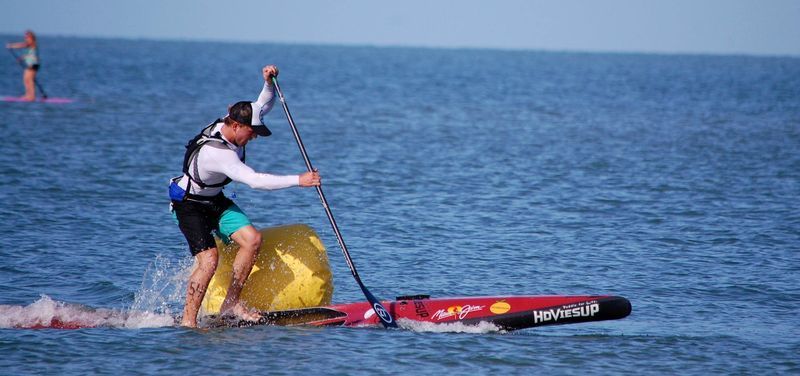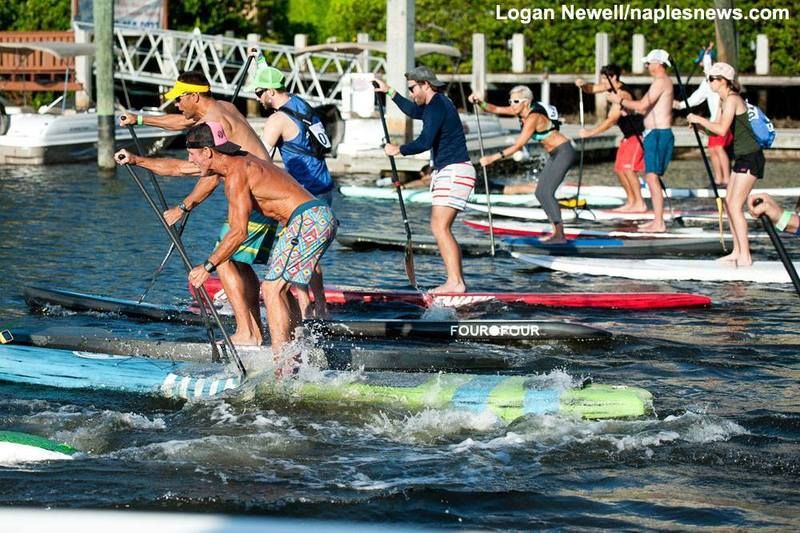
This was a race that the rest of the CGT race team and I were really looking forward to because:
A) It was a big WPA-sanctioned race with sponsors and prize money attracting good athletes from around Florida.
B) It was practically in our backyard at Fort Myers Beach.
C) It was tied in with local organizations doing good things: It was organized by the SW FL sup club and the "Calusa Blueway" and it raised money to benefit the Special Olympics.
The course started with a beach launch, then had a rectangular circuit up and down the north end of Fort Myers Beach. There was a short race with just one lap around the circuit, and a longer "Ron Jon Pro" race with three laps around the circuit. I did the longer race, which was 6.24 miles on my GPS. The course wasn't too complicated, but all those buoy turns put a premium on being able to make quick, efficient turns without slowing down or falling off. I didn't fall off but my turns were "meh" - definitely something to work on.

Here's a play-by-play of what I can remember about how the race went:
1) I used my 14' x 24.75" Fanatic Falcon with a MFC weed-wave fin and a Riviera Vantage 8.0 paddle.
2) We lined up on the beach for a running beach start. The fast, sponsored riders flung their boards down, leaped on and blasted off like missiles. I was slow on the draw but sprinted pretty well once onboard and arrived at the first buoy somewhere in the front third of the pack.

3) My turn at the crowded first buoy was awkward, bumping some other guys' boards and stuff. But I kept a sprint going and passed some of the fast-starting 12'6 boards on my way around the pier to the "circuit" part of the race course. I think that practicing 2 minute sprint intervals last week with a new training buddy, South African kayaker & sup'er Murray Hunkin, helped me a lot with this part of the race.
4) Starting the first leg of the circuit I was about 200 feet behind the young, fast 14' riders: Matt Arensman, Kieran Grant, and Brad Ward. My sprint energy was wearing out, but I saw an opportunity to catch them when they made the strategic error of paddling in the shallow water too close to shore. Deeper water is faster, plus the favorable flood tide current was stronger in the deeper water where I stayed. Also, the large breaking wake from the Ft. Myers - Key West Ferry roared through the shallows at about 8:45 am and the fast guys had to negotiate that while I was deep enough to get over the swells. After the ferry wake I was close enough behind the leaders to sneak and start drafting Brad Ward who was in third place at the time.
5) I focused on spending the minimum effort necessary to catch my breath while drafting Brad Ward. It was working pretty well, but somewhere on the return leg of the first circuit Brad got a little slower and disconnected from the two leaders. I decided I should take a turn in front of him so I passed, but I didn't think I had the speed and energy to catch up with either Matt Arensman or Kieran Grant, who were now separated from each other and 100-200 feet ahead of me.
Matt Arensman being a badass.

Kieran Grant being a badass.

I was thinking it would be a battle for third place between me and Brad Ward, but something happened to Brad and he dropped out of the race instead of getting in my draft. Later I asked him what happened and he explained that had a chronic forearm injury that he was hoping to control with two compression sleeves on it, but it flared up real bad and he wisely ended the race before making it worse. There have been tons of long, tough races in Florida this spring, and I'm sure it puts brutal wear and tear on the competitive riders like Brad that push it 100% in all of them.
6) My goal for the rest of the race was to stay in third place in the 14' division and not get passed by the top 12'6 riders. I knew the 12'6 guys weren't too far behind me because I could periodically hear Mark Athanacio yelling things while mixing it up in the draft train of 12'6'ers (see guy in red shorts in picture).

I had some friendly company in the middle part of the race from a guy on an orange 17' Unlimited class sup.

He was keeping up with me without even having to push it, using the race as just a warm up for the kayak race he was going to do later! I was working hard but staying within the bounds of what I knew (or at least hoped) I could maintain. Sips of watered-down gatorade from my camelback helped.
7) The last lap was toughest, as the temperature was rising and the wind had picked up and shifted more sideshore from offshore. The leaders continued to get way ahead (4-5 minutes ahead) of me, and I didn't put any more distance between myself and the 12'6 guys behind me. But I dutifully spent all the energy I had left in the final shot to the beach and through the flags to finish in 1:10:16. Matt Arensman won it in 1:05:01 and Kieran Grant was second in 1:06:13. Assuming my GPS odometer was accurate at 6.24 miles, my pace was 5.33 mph, which is not impressive compared to my 5.55 mph pace in the longer Orange Bowl sup race earlier this month, or Mr. Arensman's 5.76 mph pace in this race. Having 13 buoy turns and slightly bumpier water is probably part of what made me slower. It's also possible that I just didn't push myself as hard during the middle endurance part of the race, or that my energy systems were a bit down from having two beers and only getting 5 1/2 hours of sleep after playing Dungeons and Dragons the night before. For future pre-race training I'm going to make sure to frequently practice buoy turns, focus on maintaining efficient form and pace when I'm tired, and make sure I'm well rested and hydrated with water only.
The other CGT team folks all finished strong, and kayak veteran / sup rookie Murray Hunkin did super well, coming in first in the 40-49 year old 14' division despite barely being able to do a buoy turn. I need to keep training with that guy.
The race had cool BIG trophies made by local artist and craftsman Steve Nagy. There were also money awards for the top 5 finishers in mens' 14' and 12'6, and womens' 12'6 class. I got $500 for third in the 14' class, which I am super stoked about. I think it's the first time I've ever won money for doing something athletic.

There will be a bit of a break before the next SUP race I'm signed up for, which is nice because I'll be busy with real life work and some trips and stuff with Rhonda.



















